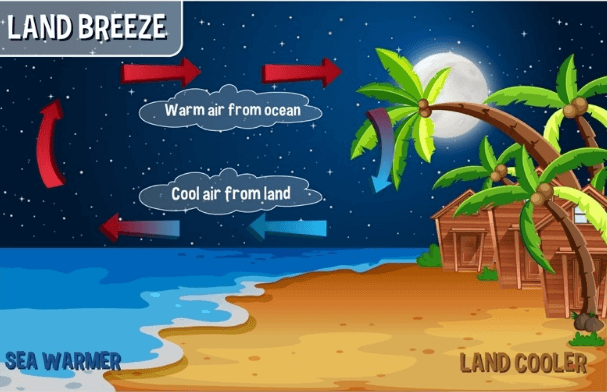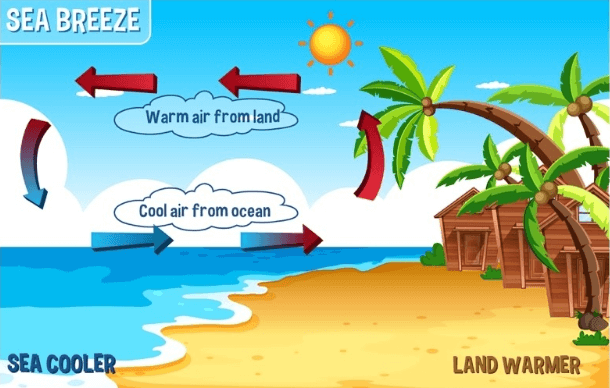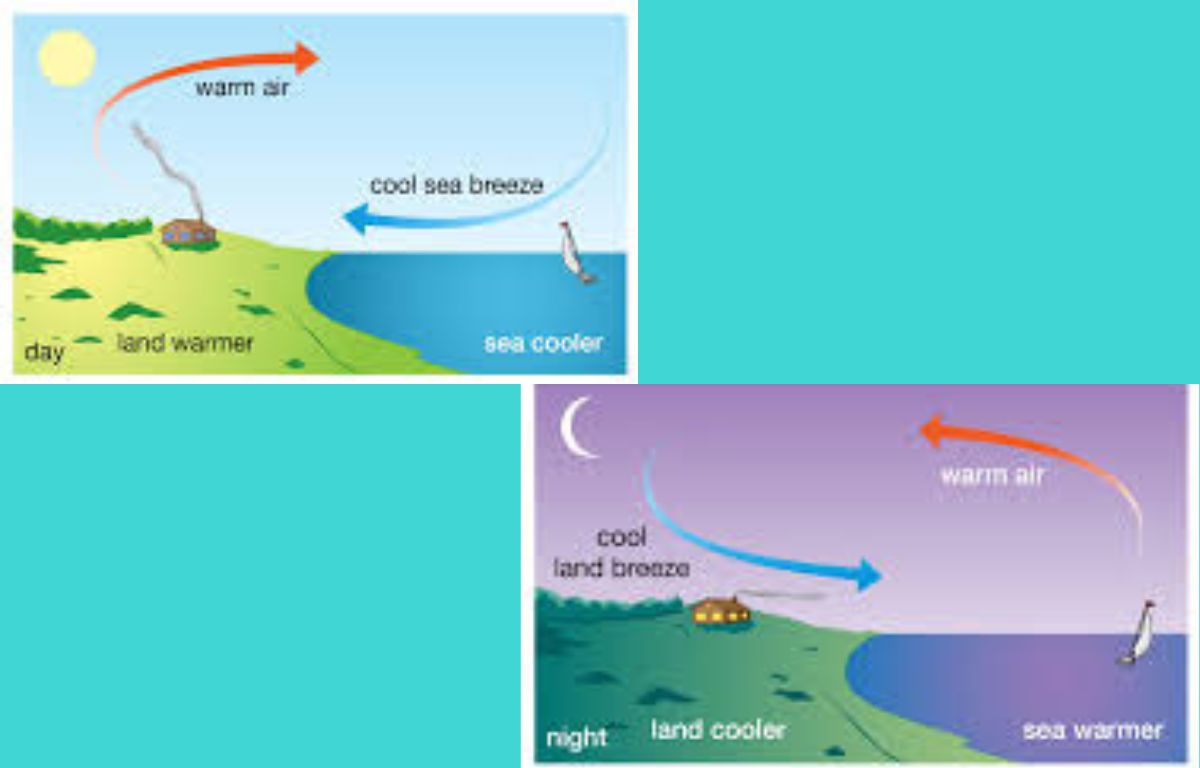What is Land Breeze?
A land breeze is a gentle wind that flows from the land towards the sea, usually at night. This happens because, during the evening, land cools down faster than water. As the air over the cooler land becomes dense, it sinks and moves towards the sea, where the air is warmer and lighter. The warm air rises, creating a cycle that pulls cool air from the land to fill the space. Land breezes are usually mild and help balance temperature between land and sea, bringing a refreshing, cool breeze along the coastline.

What is Sea Breeze?
A sea breeze is a cold wind that blows from the seat towards the land, usually during the daytime. This happens because the land heats up faster than the sea under the sun. As the air over the land becomes warmer, it rises up, creating an empty space. Cooler air from the sea then moves in to fill this space, creating a breeze. Sea breezes are common in coastal areas, especially on warm and sunny days, and they help to cool down the land. This breeze makes beach areas feel fresher and more comfortable, especially on hot days. At night, the process can reverse, creating a land breeze that blows from the land to the sea.

Difference Between Land Breeze and Sea Breeze
This table summarizes the key differences between land breezes and sea breezes, highlighting their causes, effects, implications, and many more.
| Difference Between Land Breeze and Sea Breeze | ||
| Aspects | Land Breeze | Sea Breeze |
| Definition | A land breeze is a cool breeze that blows from the land to the sea during the night. | A sea breeze is a cool breeze that blows from the sea to the land during the day. |
| Time of Occurrence | Occurs at night when the land cools faster than the sea. | Occurs during the day when the land heats up faster than the sea. |
| Temperature | The air over the land becomes cooler and denser, leading to a breeze towards the sea. | The air over the sea remains cooler, creating a pressure difference that drives the breeze towards the land. |
| Direction of Wind | Winds blow from land towards the sea. | Winds blow from the sea towards the land. |
| Pressure Systems | Higher pressure develops over the land due to cooling. | Lower pressure develops over the land due to heating |
| Effect on Weather | Can lead to calm and clear weather over the sea at night. | Often brings cooler temperatures and can increase humidity on land during the day. |
| Influence on Marine Life | Less influence, as it occurs at night when marine activity is lower. | Can enhance marine activity, bringing nutrients from deeper waters to the surface. |
| Local Variations | More common in coastal areas with distinct land and sea temperature differences. | More common in coastal regions where land and sea temperature disparities are significant. |
Importance of Land and Sea Breeze
Land breezes and sea breezes are essential natural phenomena that help regulate coastal temperatures, impacting local weather patterns and ecosystems. Together, these breezes create a balanced temperature environment in coastal areas, benefiting both land and sea ecosystems and making these regions pleasant for people, animals, and plants alike. Here’s why both are important:
Sea Breeze:
- Cooling Effect: During the day, the land heats up faster than the sea, causing warm air to rise over the land. This pulls in cooler, moist air from the sea, creating a refreshing breeze. This effect helps to cool down coastal areas, making them more comfortable.
- Supports Aquatic Life: The cooler sea breeze helps moderate temperatures, which is beneficial for marine life, as extreme temperatures can disrupt marine ecosystems.
- Boosts Agriculture: The moist sea breeze can help maintain humidity levels near the coast, which supports the growth of certain crops that require moisture.
Land Breeze:
- Night Cooling: At night, the land cools faster than the sea, creating a land breeze as cooler air moves out to sea. This land breeze helps maintain ocean temperature stability, supporting marine life by preventing sudden changes in water temperature.
- Supports Fishing: Land breezes can drive plankton and small fish closer to the shore, benefiting coastal fishing communities by making it easier to find fish near the shore.



 Ohm's Law: Definition, Formula, Limitati...
Ohm's Law: Definition, Formula, Limitati...
 Newton's First Law of Motion: Definition...
Newton's First Law of Motion: Definition...
 Kepler's Laws of Planetary Motion: First...
Kepler's Laws of Planetary Motion: First...










